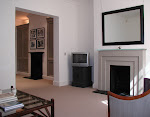In a city such as Rome a vast proportion of refurbishments take place within historical buildings. Obiously protected by conservation laws, these buildings are also safeguarded by the inborne love of historical detail present in most Italian architects. Interestingly, in Italian the words "refurbishment" and "restoration" have virtually idential meanings and there is a single translation for both terms: "restauro". The framework of each project is set by the historical value of the structure. This however in no way limits the immagination and capacity for experimentation of some young architects. While searching for a valid example of a  small scale project to demostrate the work of young Roman architects I noticed this 60 sq m space developed into a studio by a young Roman architect, Carola Vannini. Here an old store space under the arches in Piazza Vittorio (in the area of Rome known as the Esquilino) has been restored with great understanding of past, present and world trends.
small scale project to demostrate the work of young Roman architects I noticed this 60 sq m space developed into a studio by a young Roman architect, Carola Vannini. Here an old store space under the arches in Piazza Vittorio (in the area of Rome known as the Esquilino) has been restored with great understanding of past, present and world trends.
 small scale project to demostrate the work of young Roman architects I noticed this 60 sq m space developed into a studio by a young Roman architect, Carola Vannini. Here an old store space under the arches in Piazza Vittorio (in the area of Rome known as the Esquilino) has been restored with great understanding of past, present and world trends.
small scale project to demostrate the work of young Roman architects I noticed this 60 sq m space developed into a studio by a young Roman architect, Carola Vannini. Here an old store space under the arches in Piazza Vittorio (in the area of Rome known as the Esquilino) has been restored with great understanding of past, present and world trends.

